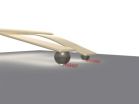(Press-News.org) Dr Angela Attwood and colleagues from Bristol's School of Experimental Psychology recruited 160 social drinkers aged 18-40 with no history of alcoholism to attend two experimental sessions. At one session they were asked to drink either lager or a non-alcoholic soft drink from either a straight-sided glass or a curved 'beer flute'.
The participants were almost twice as slow when drinking alcohol from the straight-sided glass compared to the curved glass. There was no difference in drinking rates from the glasses when the drink was non-alcoholic.
The researchers suggest that the reason for this may be because it is more difficult to accurately judge the halfway point of shaped glasses. As a result, drinkers are less able to gauge how much they have consumed.
In order to test this, participants attended another session in which they completed a computer task that presented numerous pictures of the two glasses containing varying volumes of liquid. By asking participants to judge whether the glass was more or less than half full, the researchers were able to show that there was greater error in accurately judging the halfway point of the curved glass.
Importantly, the degree of this error seemed to be associated with the speed of drinking. That is, the participants who tended to show the greatest error in their halfway judgments tended to show the greatest changes in drinking rate.
The speed at which an alcoholic beverage is drunk will influence the level of intoxication experienced, and also the number of drinks consumed in a single drinking session. Therefore, slowing drinking rates is likely to have positive impact for the individual and also at a population level.
Dr Attwood said: "Due to the personal and societal harms associated with heavy bouts of drinking, there has been a lot of recent interest in alcohol control strategies. While many people drink alcohol responsibly, it is not difficult to have 'one too many' and become intoxicated. Because of the negative effects alcohol has on decision making and control of behaviour, this opens us up to a number of risks.
"People often talk of 'pacing themselves' when drinking alcohol as a means of controlling levels of drunkenness, and I think the important point to take from our research is that the ability to pace effectively may be compromised when drinking from certain types of glasses."
### END
Glass shape influences how quickly we drink alcohol
2012-08-31
ELSE PRESS RELEASES FROM THIS DATE:
Researchers develop new, less expensive nanolithography technique
2012-08-31
Researchers from North Carolina State University have developed a new nanolithography technique that is less expensive than other approaches and can be used to create technologies with biomedical applications.
"Among other things, this type of lithography can be used to manufacture chips for use in biological sensors that can identify target molecules, such as proteins or genetic material associated with specific medical conditions," says Dr. Albena Ivanisevic, co-author of a paper describing the research. Ivanisevic is an associate professor of materials science and ...
Fear and driving opportunity motivated changes in driving behavior after 9/11
2012-08-31
A catastrophic event – such as a terrorist attack, a natural disaster, or market collapse – often strikes twice. There is the damage caused by the event itself, as lives are lost or left in ruin. But there is also the second act, catalyzed by our response to the catastrophic event. This second act has the potential to cause just as much damage as the first.
In the year following the terrorist attacks of September 11, 2001, there were approximately 1,600 more traffic fatalities in the United States than expected. This figure suggests the possibility that fear may have ...
Research yields two 'firsts' regarding protein crucial to human cardiac function
2012-08-31
TALLAHASSEE, Fla. -- Florida State University researchers led by physics doctoral student Campion Loong have achieved significant benchmarks in a study of the human cardiac protein alpha-tropomyosin, which is an essential, molecular-level component that controls the heart's contraction on every beat.
Using an imaging method called atomic force microscopy, Loong achieved two "firsts": the first direct imaging of individual alpha-tropomyosin molecules, which are very small — roughly 40 nanometers long — and the first demonstrated examples of a measure of the human cardiac ...
BUSM researchers study use of MRI in osteoarthritis
2012-08-31
(Boston) – A study conducted by researchers at Boston University School of Medicine (BUSM) shows that magnetic resonance imaging (MRI) detected a high prevalence of abnormalities associated with knee osteoarthritis in middle-aged and elderly patients that had no evidence of knee osteoarthritis in X-ray images.
Ali Guermazi, MD, PhD, professor of radiology at BUSM and chief of Musculoskeletal Imaging at Boston Medical Center (BMC), led this study in collaboration with researchers from Lund University in Sweden, Brigham and Women's Hospital in Boston and Klinikum Augsburg ...
BUSM researchers find potential key to halt progression, reverse damage from emphysema
2012-08-31
(Boston) – A study led by researchers at Boston University School of Medicine (BUSM) has shown that a compound used in some skin creams may halt the progression of emphysema and reverse some of the damage caused by the disease. When the compound Gly-His-Lys (GHK) was applied to lung cells from patients with emphysema, normal gene activity in altered cells was restored and damaged aspects of cellular function were repaired.
The study, which is published in BioMed Central's open access journal Genome Medicine, also demonstrates the potential impact of using genomic technologies ...
Mobile apps for diabetes present usability issues for older adults
2012-08-31
Diabetes is prevalent among adults aged 65 and older and can lead to a number of other serious health issues. Maintaining control of blood glucose levels is one of the most important actions diabetics can take to control their illness. New technology is designed to make self-monitoring easier and more accessible than ever before, but often tech products fail to accommodate some older users. Human factors/ergonomics researchers Laura A. Whitlock and Anne Collins McLaughlin evaluated the usability issues that older adults may experience with one type of emerging technology, ...
Wayne State researchers say adolescent smoking prevention programs still critical
2012-08-31
DETROIT — While many might see the case for programs to prevent adolescent cigarette smoking as already made, a pair of Wayne State University researchers believes that due to increasingly challenging economic times, policymakers need to be reminded to continue allocating funding for such programs.
Xinguang Chen, M.D., Ph.D., professor of pediatrics in the School of Medicine, and Feng Lin, Ph.D., professor of electrical and computer engineering in the College of Engineering, have found a way to provide policymakers with some hard evidence.
Most adult smokers in the ...
AGU journal highlights -- 31 August 2012
2012-08-31
The following highlights summarize research papers that have been recently
published in Geophysical Research Letters (GRL), Journal of Geophysical
Research - Biogeosciences (JGR-G), Journal of Geophysical Research -
Atmospheres (JGR-D), Water Resources Research (WRR), and Space Weather
(SW).
In this release:
1. Trade-offs between water for food and for curbing climate change
2. Low calcification in corals in the Great Barrier Reef
3. The Everglades still threatened by excess nutrients
4. Wetlands the primary source of Amazon Basin methane
5. Old fractures ...
Cleveland Clinic researchers investigating potential drug for treatment of Alzheimer's disease
2012-08-31
Friday, Aug. 31, 2012, Cleveland: A compound developed to treat neuropathic pain has shown potential as an innovative treatment for Alzheimer's disease, according to a study by researchers at Cleveland Clinic's Lerner Research Institute and Anesthesiology Institute.
"Cleveland Clinic dedicated two years of research into the examination of this compound and our findings show it could represent a novel therapeutic target in the treatment of Alzheimer's disease," said Mohamed Naguib, M.D., Professor of Anesthesiology, Cleveland Clinic Lerner College of Medicine. "Development ...
International collaboration key to science and engineering globalization
2012-08-31
International collaboration is a key aspect of the globalization of science and engineering. A recent report and data evaluation released by the National Science Foundation (NSF) showed that one in six scientists and engineers in the United States reported working with individuals in other countries in a given week. International collaboration was more likely to occur among persons working in the for-profit sector, men, and those with higher levels of educational attainment. Individuals who earned postsecondary degrees both in the United States and abroad reported the highest ...


